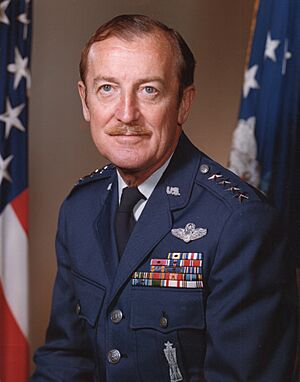F. Michael Rogers facts for kids
Quick facts for kids
Felix Michael Rogers
|
|
|---|---|
 |
|
| Born | July 6, 1921 Somerville, Massachusetts, US |
| Died | April 23, 2014 (aged 92) Walter Reed National Military Medical Center, Bethesda, Maryland, US |
| Buried | |
| Allegiance | United States |
| Service/ |
United States Air Force |
| Years of service | 1942–1978 |
| Rank | |
| Commands held | 353rd Fighter Squadron 77th Fighter Squadron Vice Commander Air Training Command Air University Air Force Logistics Command |
| Battles/wars | World War II Cold War Korean War Vietnam War |
Felix Michael Rogers (July 6, 1921 – April 23, 2014) was a very important general in the United States Air Force. He was usually known as Michael Rogers. He was the commander of the Air Force Logistics Command. This command is based at Wright-Patterson Air Force Base in Ohio. Its job is to make sure the Air Force has all the supplies and equipment it needs around the world. General Rogers also helped other countries and U.S. government groups. He was a graduate of the National War College.
Contents
Biography
Early Life and World War II Heroics
Michael Rogers was born in Somerville, Massachusetts, in 1921. He finished high school in Newtonville in 1939. In April 1942, he joined the military as a private. By August 1942, he was training to be a pilot. He became a second lieutenant and a pilot in 1943. This happened in Yuma, Arizona.
During World War II, Rogers flew P-39 Airacobra planes. He was part of the 353rd Fighter Squadron. He later moved with his squadron to Europe. There, he flew P-51 Mustang aircraft. He became the commander of his squadron. Rogers was a "fighter ace." This means he shot down 12 enemy planes. He flew these missions from bases in England, Italy, and France.
Post-War Service and Education
In January 1945, Rogers returned to the United States. He continued flying fighter planes. Later, he became the commandant of troops at Hunter Field, Georgia. From 1946 to 1947, he served as a flight commander. He also led the 77th Fighter Squadron at Shaw Air Force Base, South Carolina.
Rogers then went to the University of Virginia. He studied there from 1947 to 1949. This was part of an Air Force Institute of Technology program. In 1949, he joined the Headquarters of the United States Air Force. He worked as an intelligence officer. He also studied languages at Lacaze Academy in Washington D.C.. This helped him prepare for duties as an attaché. In 1952, he earned a bachelor's degree from the University of Maryland.
Diplomatic and Leadership Roles
From 1953 to 1957, Rogers served in Madrid, Spain. He was an assistant air attaché there. After that, he returned to the U.S. Air Force Headquarters. He became chief of the Current Intelligence Branch. In 1958, he moved to the Joint Chiefs of Staff. He became the director of current intelligence. In 1960, he attended the National War College. The next year, he worked with the Office of the Assistant Secretary of Defense.
Later Career and Retirement
Rogers held several important roles in the Air Force. From 1962 to 1963, he was secretary of the Air Force Council. He then became director of the secretariat. In 1966, he joined the Air Force Systems Command. He became deputy chief of staff for development plans in 1968.
From 1970 to 1971, Rogers served in Korea. He was a senior member of the United Nations Command, Military Armistice Commission. In 1971, he became deputy chief of staff for technical training. This was at Air Training Command Headquarters. He became vice commander of Air Training Command in 1972.
In 1973, Rogers was appointed commander of the Air University. This was at Maxwell Air Force Base, Alabama. In this role, he managed education programs for Air Force officers and non-commissioned officers. In August 1975, he became commander of the Air Force Logistics Command. He was promoted to the rank of general on September 1, 1975.
General Rogers retired from the Air Force on January 31, 1978. After retiring, he helped start an airline called MGM Grand Air. He lived in Santa Barbara, California, until he passed away in 2014. He died from complications of a health issue. He is buried at Arlington National Cemetery.
Awards
Here are some of the awards General Rogers earned during his career:
 USAF Command pilot badge USAF Command pilot badge |
|
| Air Force Distinguished Service Medal with three bronze oak leaf clusters | |
| Silver Star | |
| Legion of Merit with bronze oak leaf cluster | |
| Distinguished Flying Cross with bronze oak leaf cluster | |
| Bronze Star Medal | |
| Air Medal with four silver oak leaf clusters | |
| Air Force Presidential Unit Citation with bronze oak leaf cluster | |
| American Campaign Medal | |
| European-African-Middle Eastern Campaign Medal with silver and bronze campaign stars | |
| World War II Victory Medal | |
| National Defense Service Medal with bronze service star | |
| Armed Forces Expeditionary Medal | |
| Korea Defense Service Medal | |
| Air Force Longevity Service Award with one silver and two bronze oak leaf clusters | |
| Small Arms Expert Marksmanship Ribbon | |
| Order of Aeronautical Merit (Spain) | |
| Order of National Security Merit, 3rd class (South Korea) | |

